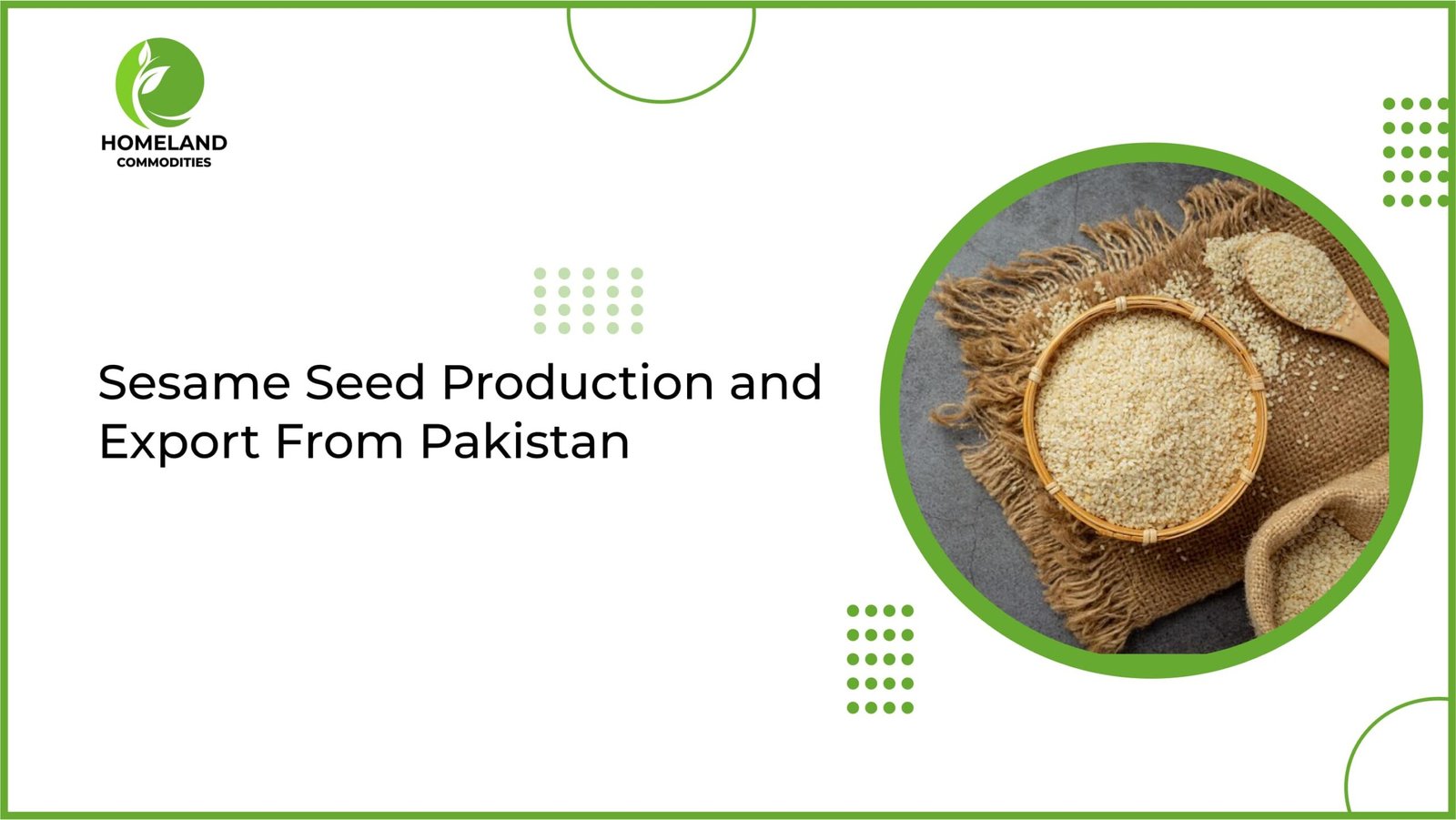Sesame Seed Production and Export from Pakistan
Sesame seeds, small yet highly valued oil-rich seeds, are a cornerstone of Pakistan’s agricultural economy. Cultivated primarily in the Sindh and Punjab provinces, these seeds thrive in the region’s warm climate and fertile soils. Known for their rich nutritional content and versatility in culinary applications, sesame seeds are a staple crop for local farmers and a significant export commodity, contributing to Pakistan’s foreign exchange earnings. The industry’s growth is driven by both traditional farming practices and modern techniques, ensuring a steady supply to meet global demand.
Sesame Seed Cultivation in Pakistan
- Geographic Distribution and Climate Requirements: In Pakistan, sesame is primarily cultivated in the Sindh and Punjab provinces. The crop thrives in tropical and subtropical regions with well-drained soils and adequate sunlight. Optimal growing conditions include temperatures between 25°C and 35°C and moderate rainfall.
- Varieties of Sesame Grown in Pakistan: Pakistan grows several sesame varieties, including white, black, and brown seeds. Each variety has specific uses and market demands, with white sesame being the most commonly exported due to its high oil content and aesthetic appeal.
- Soil Requirements and Farming Practices: Sesame requires well-drained, sandy loam soils with a neutral pH. Traditional farming practices in Pakistan involve minimal tillage, crop rotation, and organic fertilization. Modern techniques are gradually being adopted to increase yield and efficiency.
Sesame Seed Production
Pakistan is the fifth largest country in the world for sesame production and exports. In 2018, Pakistan produced 29,000 tons of sesame seeds from 176,000 acres of land. In 2019, the country exported over 400 million tons of sesame seeds worth Rs 9000 million. In 2020, Pakistan’s sesame exports were valued at $89.32 million, but by 2023, that number had increased to $407 million, making Pakistan the fifth largest exporter of sesame seeds in the world. More than 80% of Pakistan’s sesame exports go to China.
Sesame is a cash crop that can be grown in both irrigated and rain-fed conditions in about 65 districts across Pakistan’s Punjab, Sindh, Khyber Pakhtunkhwa, and Balochistan provinces. The best time to sow sesame seeds is between June 15 and July 15, and the recommended seeding rate is 1.5–2 kilograms per acre. The average yield of sesame seeds in Pakistan has increased from 442 kilograms per hectare to 750 kilograms per hectare due to the National Oilseeds Enhancement Program (NOEP), a collaborative effort between the Ministry of National Food Security and Research and provincial governments.
Sesame seeds are high in protein and oil, containing around 22% protein and 50–60% oil. They are also considered a profitable crop to grow because they can be grown using equipment used for other crops, and they offer a higher return for less cost than other crops.
Steps in Sesame Seed Production
- Seed Selection and Preparation: Selecting high-quality seeds is crucial for achieving a good harvest. Seeds should be sourced from reputable suppliers and treated to prevent fungal infections. Proper seed preparation ensures uniform germination and healthy plant growth.
- Land Preparation and Sowing: Land preparation involves plowing, harrowing, and leveling the soil to create an ideal seedbed. Sowing is typically done in rows, either manually or using seed drills, to ensure even distribution and optimal plant spacing.
- Irrigation and Crop Management: Although sesame is drought-tolerant, timely irrigation is essential during critical growth stages, such as flowering and seed formation. Crop management practices include weeding, thinning, and applying organic or chemical fertilizers to promote healthy growth.
- Pest and Disease Control: Common pests affecting sesame include aphids, whiteflies, and bollworms. Diseases like bacterial blight and leaf spot can also impact yields. Integrated pest management (IPM) strategies, including biological control and judicious use of pesticides, help mitigate these threats.
- Harvesting and Post-Harvest Handling: Sesame is harvested when the seed pods turn brown and begin to split. Harvesting can be done manually or mechanically. Post-harvest handling includes drying, threshing, and cleaning the seeds to remove impurities and prepare them for processing or export.
Processing of Sesame Seeds
- Cleaning and Sorting: After harvesting, sesame seeds undergo cleaning to remove dirt, stones, and other foreign materials. Sorting is done to separate seeds based on size, color, and quality, ensuring a uniform product for the market.
- Drying and Storage: Proper drying reduces the moisture content of sesame seeds, preventing mold growth and spoilage. Seeds are typically sun-dried or dried using mechanical dryers. Once dried, they are stored in cool, dry conditions to maintain their quality and extend shelf life.
Quality Standards and Regulations
- International Quality Standards for Sesame Seeds: Sesame seeds must meet various international quality standards, including purity, moisture content, and the absence of contaminants. Standards are set by organizations such as the International Organization for Standardization (ISO) and the Food and Agriculture Organization (FAO).
- Regulations in Pakistan Regarding Sesame Seed Production and Export: Pakistan has its own set of regulations governing sesame seed production and export, including quality control measures and export documentation. Compliance with these regulations ensures that Pakistani sesame seeds meet international market requirements.
Exporting Sesame Seeds from Pakistan
Sesame seeds are a leading oil seed export commodity for Pakistan. In 2023, Pakistan exported $290.66 million worth of sesame seeds to China, which was a 126.29% increase from the previous year. This made Pakistan the second largest exporter of sesame seeds to China in 2023, after Niger. In total, Pakistan contributed to about 19% of China’s sesame seed imports in 2023.
- Factors Contributing to Pakistan’s Sesame Seed Exports: Pakistan’s sesame seed exports are attributed to a combination of factors, including favorable climate, agricultural policies, and market positioning. Sesame seeds can be grown as a rain crop or in irrigated areas across six Pakistani provinces, including Punjab, Sindh, NWFP, and Baluchistan. The best time to sow the seeds is between June 15 and July 15, and the recommended seeding rate is 1.5–2 kilograms per acre. Sesame is also considered a profitable crop to grow, even with limited resources.
- Export Procedures for Sesame Seeds: Exporting sesame seeds involves several steps, including obtaining export licenses, complying with phytosanitary regulations, and ensuring proper packaging. Exporters must also navigate customs procedures and secure reliable transportation.
- Export Documentation and Compliance Requirements: Essential export documents include the Certificate of Origin, Phytosanitary Certificate, and Commercial Invoice. Compliance with destination country regulations, such as maximum residue levels for pesticides, is crucial to avoid shipment rejections.
- Major Destinations for Pakistani Sesame Seeds: Pakistani sesame seeds are exported to various countries, including China, Japan, South Korea, and the Middle East. These markets demand high-quality seeds for use in food products, oil extraction, and traditional medicines.
- Trends and Statistics in Sesame Seed Export: The export volume of Pakistani sesame seeds has been steadily increasing, driven by rising global demand and competitive pricing. Statistical data on export values, volumes, and market shares provide insights into the sector’s growth and potential.
Challenges in Sesame Seed Export
- Environmental Challenges: Climate change and unpredictable weather patterns pose significant risks to sesame production, affecting both yield and quality.
- Market Challenges and Price Volatility: Fluctuations in global market prices can impact the profitability of sesame exports. Exporters must navigate these uncertainties through strategic planning and market diversification.
- Technological and Infrastructure Constraints: Limited access to advanced farming technologies and infrastructure can hinder productivity and competitiveness. Investments in modern equipment and storage facilities are needed to overcome these challenges.
Opportunities in the Export Market
- Emerging Markets and Opportunities: New markets in Africa, Europe, and South America are emerging, offering opportunities for Pakistani sesame exporters to expand their reach.
- Potential for Value Addition and Processing; Value-added products like sesame oil, tahini, and sesame-based snacks have high market potential. Investing in processing facilities can enhance profitability.
- Government Initiatives and Support: The Pakistani government provides various incentives and support programs to boost agricultural exports, including subsidies, training programs, and trade facilitation measures.
Conclusion
Sesame seed production and export play a crucial role in Pakistan’s agricultural sector, offering substantial economic benefits and employment opportunities. By adhering to international quality standards and overcoming export challenges, Pakistan can continue to expand its market reach and enhance its global competitiveness. The ongoing investment in modern farming technologies, value addition, and government support further strengthens the industry’s potential, making sesame seeds a vital contributor to the country’s agricultural and economic landscape.


